Carbon Rovings as Strain Sensor in TRC Structures: Effect of Roving Cross-Sectional Shape and Coating Material on the Electrical Response under Bending Stress
Abstract
1. Introduction
2. Carbon Rovings as Strain Sensors
3. Materials and Methods
3.1. Textile Manufacturing
3.2. Textile Coating
3.3. Concreting
3.4. Experimental Setup
4. Results
4.1. Mechanical Results under Strain
4.2. Electrical Results under Strain
5. Discussion
5.1. Mechanical Investigations under Strain
5.2. Electrical Investigations under Strain
6. Conclusions
Author Contributions
Funding
Institutional Review Board Statement
Informed Consent Statement
Data Availability Statement
Conflicts of Interest
References
- Lee, M.; Mata-Falcón, J.; Popescu, M.; Block, P.; Kaufmann, W. Potential Approaches for Reinforcing Complex Concrete Structures with Integrated Flexible Formwork. In Proceedings of the Second RILEM International Conference on Concrete and Digital Fabrication, Eindhoven, The Netherlands, 6–8 July 2020; Bos, F., Lucas, S., Wolfs, R., Salet, T., Eds.; Springer: Cham, Switzerland, 2020; Volume 28, pp. 669–679. [Google Scholar]
- Liu, S.; Zhu, D.; Wang, X.; Shi, C. Pullout properties of AR-glass textile embedded in cement matrix under different velocities and temperatures. Constr. Build. Mater. 2019, 228, 116779. [Google Scholar] [CrossRef]
- Liu, Z.; Kleiner, Y. State of the art review of inspection technologies for condition assessment of water pipes. Measurement 2013, 46, 1–15. [Google Scholar] [CrossRef]
- Regnier, J.; Cayla, A.; Campagne, C.; Devaux, E. In Situ Detection of Water Leakage for Textile-Reinforced Composites. Sensors 2020, 20, 6641. [Google Scholar] [CrossRef] [PubMed]
- Chen, S.; Duffield, C.; Miramini, S.; Nasim Khan Raja, B.; Zhang, L. Life-cycle modelling of concrete cracking and reinforcement corrosion in concrete bridges: A case study. Eng. Struct. 2021, 237, 112143. [Google Scholar] [CrossRef]
- Silva, R.; Silva, F. Carbon textile reinforced concrete: Materials and structural analysis. Mater. Struct. 2020, 53, 17. [Google Scholar] [CrossRef]
- Herbrand, M.; Adam, V.; Classen, M.; Kueres, D.; Hegger, J. Strengthening of Existing Bridge Structures for Shear and Bending with Carbon Textile-Reinforced Mortar. Materials 2017, 10, 1099. [Google Scholar] [CrossRef]
- Driessen-Ohlenforst, C. SMART-DECK: Multifunctional carbon-reinforced concrete interlayer for bridges. Mater. Corros. 2020, 71, 786–796. [Google Scholar] [CrossRef]
- Gabler, M. Funktionsintegrierte Faserverbundwerkstoffe-ein Beitrag zu Strukturintegrierter Sensorik. Ph.D. Dissertation, Institut für Tragkonstruktionen und Konstruktives Entwerfen der Universität Stuttgart, Stuttgart, Germany, 2012. [Google Scholar]
- Goldfeld, Y.; Quadflieg, T.; Gries, T. Sensing capabilities of carbon based TRC beam from slack to pull-out mechanism. Compos. Struct. 2017, 181, 294–305. [Google Scholar] [CrossRef]
- Hegger, J.; Curbach, M.; Stark, A.; Wilhelm, S.; Farwig, K. Innovative design concepts: Application of textile reinforced concrete to shell structures. Struct. Concr. 2018, 19, 637–646. [Google Scholar] [CrossRef]
- Perry, G.; Dittel, G.; Gries, T.; Goldfeld, Y. Mutual Effect of Textile Binding and Coating on the Structural Performance of TRC Beams. J. Mater. Civ. Eng. 2020, 32, 04020232. [Google Scholar] [CrossRef]
- Raupach, M.; Morales Cruz, C. Textile-reinforced concrete: Selected case studies. In Textile Fibre Composites in Civil Engineering; Triantaffillou, T., Ed.; Woodhead Publishing: Sawston, UK, 2016; pp. 275–299. [Google Scholar]
- Friese, D.; Scheurer, M.; Hahn, L.; Gries, T.; Cherif, C. Textile reinforcement structures for concrete construction applications—A review. J. Compos. Mater. 2022, 56, 4041–4064. [Google Scholar] [CrossRef]
- Kulas, C. Actual applications and potential of textile-reinforced concrete. In Proceedings of the 17th International Congress of the GRCA, Dubai, United Arab Emirates, 19–21 April 2015. [Google Scholar]
- Peled, A.; Mobasher, B.; Bentur, A. Textile Reinforced Concrete; CRC Press: Boca Raton, FL, USA; London, UK; New York, NY, USA, 2017. [Google Scholar]
- Hasanbeigi, A. Global Cement Industry’s GHG Emissions. Global Efficiency Intelligence. 17 May 2021. Available online: https://www.globalefficiencyintel.com/new-blog/2021/global-cement-industry-ghg-emissions (accessed on 29 March 2023).
- Wang, W.; Konstantinidis, N.; Austin, S.; Buswell, R.; Cavalaro, S.; Cecinia, D. Flexural Behaviour of AR-Glass Textile Reinforced 3D Printed Concrete Beams. In Proceedings of the Second RILEM International Conference on Concrete and Digital Fabrication, Eindhoven, The Netherlands, 6–8 July 2020; Volume 28, pp. 728–737. [Google Scholar]
- Concrete Needs to Lose Its Colossal Carbon Footprint. Nature 2021, 597, 593–594. Available online: https://www.nature.com/articles/d41586-021-02612-5 (accessed on 29 March 2023). [CrossRef] [PubMed]
- Chatterjee, A.K. Contemporary Cement Plants: Scale, Complexity, and Operational Variables. In Intelligent and Sustainable Cement Production: Transforming to Industry 4.0 Standards, 1st ed.; Chatterjee, A.K., Ed.; CRC Press: Boca Raton, FL, USA, 2021; pp. 1–37. [Google Scholar]
- Goldfeld, Y.; Quadflieg, T.; Ben-Aarosh, S.; Gries, T. Micro and Macro Crack Sensing in TRC Beam under Cyclic Loading. J. Mech. Mater. Struct. 2017, 12, 579–601. [Google Scholar] [CrossRef]
- Soranakom, C.; Mobasher, B. Geometrical and mechanical aspects of fabric bonding and pullout in cement composites. Mater. Struct. 2009, 42, 765–777. [Google Scholar] [CrossRef]
- Goldfeld, Y.; Yosef, L. Sensing accumulated cracking with smart coated and uncoated carbon based TRC. Measurement 2019, 141, 137–151. [Google Scholar] [CrossRef]
- Valeri, P.; Fernández Ruiz, M.; Muttoni, A. Tensile response of textile reinforced concrete. Constr. Build. Mater. 2020, 258, 119517. [Google Scholar] [CrossRef]
- Goldfeld, Y.; Quadflieg, T.; Gries, T. Pre- and Post- Damage Structural Health Monitoring in Carbon Fiber Textile Reinforced Concrete (TRC) Structures. In Proceedings of the 8th European Workshop on Structural Health Monitoring, Bilbao, Spain, 5–8 July 2016; Volume 1, pp. 357–366. [Google Scholar]
- Goldfeld, Y.; Ben-Aarosh, S.; Rabinovitch, O.; Quadflieg, T.; Gries, T. Integrated self-monitoring of carbon based textile reinforced concrete beams under repeated loading in the un-cracked region. Carbon 2016, 98, 238–249. [Google Scholar] [CrossRef]
- Quadflieg, T.; Stolyarov, O.; Gries, T. Influence of the fabric construction parameters and roving type on the tensile property retention of high-performance rovings in warp-knitted reinforced fabrics and cement-based composites. J. Ind. Text. 2017, 47, 453–471. [Google Scholar] [CrossRef]
- Quadflieg, T.; Stolyarov, O.; Gries, T. Carbonfaserbewehrung als Sensor für Bauwerke. Beton- Stahlbetonbau 2017, 112, 541–544. [Google Scholar] [CrossRef]
- Goldfeld, Y.; Rabinovitch, O.; Fishbain, B.; Quadflieg, T.; Gries, T. Sensory carbon fiber based textile-reinforced concrete for smart structures. J. Intell. Mater. Syst. Struct. 2015, 27, 469–489. [Google Scholar] [CrossRef]
- Quadflieg, T.; Stolyarov, O.; Gries, T. Carbon rovings as strain sensors for structural health monitoring of engineering materials and structures. J. Strain Anal. Eng. Des. 2016, 51, 482–492. [Google Scholar] [CrossRef]
- Quadflieg, T. Gewirkte Verstärkungstextilien mit Kohlenstofffaserbasierter Sensorik im Verbundwerkstoff mit Mineralischer Matrix. Ph.D. Dissertation, Institut für Textiltechnik of RWTH Aachen University, Aachen, Germany, 2017. [Google Scholar]
- Gaben, M.; Goldfeld, Y. Self-sensory carbon-based textile reinforced concrete beams—Characterization of the structural-electrical response by AC measurements. Sens. Actuators A Phys. 2021, 334, 113322. [Google Scholar] [CrossRef]
- Owens Corning. Product Data Sheet CEM-FIL® 5325 Performance for Minimal Cover. 2023. Available online: https://dcpd6wotaa0mb.cloudfront.net/mdms/dms/CSB/10025107/10025107-Cem-FIL-5325-Product-Data-Sheet.pdf?v=1642999830000 (accessed on 29 March 2023).
- SGL Group: The Carbon Company. Specification sheet Composites—Fibers and Materials, SIGRAFIL® Continuous Carbon Fiber Tow; SGL Technologies GmbH: Meitingen, Germany, 2017. [Google Scholar]
- Kyosev, Y. Warp Knitted Fabrics Construction, 1st ed.; CRC Press: Boca Raton, FL, USA, 2019. [Google Scholar]
- Hahn, L. Entwicklung einer In-Situ-Beschichtungs- und Trocknungstechnologie für Multiaxiale Gelegestrukturen mit Hohem Leistungsvermögen. Ph.D. Dissertation, Technische Universität Dresden, Dresden, Germany, 2020. [Google Scholar]
- Rampini, M.; Zani, G.; Schouler, L.; Colombo, M.; di Prisco, M. Effect of Textile Characteristics on the AR-Glass Fabric Efficiency. Textiles 2021, 1, 387–404. [Google Scholar] [CrossRef]
- Zschimmer & Schwarz, Lefatex Chemie GmbH. Specification Sheet—Lefasol VL 90/1; Zschimmer & Schwarz: Brüggen, Germany, 2020. [Google Scholar]
- Sonderforschungsbereich—SFB 532: Textilbewehrter Beton—Grundlagen für die Entwicklung einer neuartigen Technologie; Arbeits- und Ergebnisbericht; Lehrstuhl und Institut für Massivbau Aachen: Aachen, Germany, 2002.
- Brockmann, T. Mechanical and Fracture Mechanical Properties of Fine Grained Concrete for Textile Reinforced Composites. Aachener Beiträge zur Bauforschung. Ph.D. Dissertation, RWTH Aachen University, Aachen, Germany, 2006. [Google Scholar]
- EN ISO 139:2011-10; ISO_139:2005_+_Amd.1:2011; Deutsche Fassung EN_ISO_139:2005_+_A1:2011; Textilien_- Normalklimate für die Probenvorbereitung und Prüfung. Beuth Verlag GmbH: Berlin, Germany, 2011.
- Wayne Kerr Electronics. User Manual LCR Meter 4310 4320 4350 43100 43200; Wayne Kerr Electronics: Bognor Regis, UK, 2011. [Google Scholar]
- Wayne Kerr Electronics. Data Sheet LCR Meter 4300 Series. Available online: https://www.waynekerrtest.com/datasheet/instruments/wk4300.pdf (accessed on 21 April 2023).
- Dittel, G.; Heins, K.; Gries, T. Development and design of smart textile reinforcement for concrete pipes. In Symposium Papers: Materials, Analysis, Structural Design and Applications of Textile Reinforced Concrete/Fabric Reinforced Cementitious Matrix, Proceedings of the Concrete Convention and Exposition, Cincinnati, OH, USA, 20–24 October 2019; ACI Special Puclication: Red Hook, NY, USA, 2019; Volume 345, pp. 128–142. [Google Scholar]



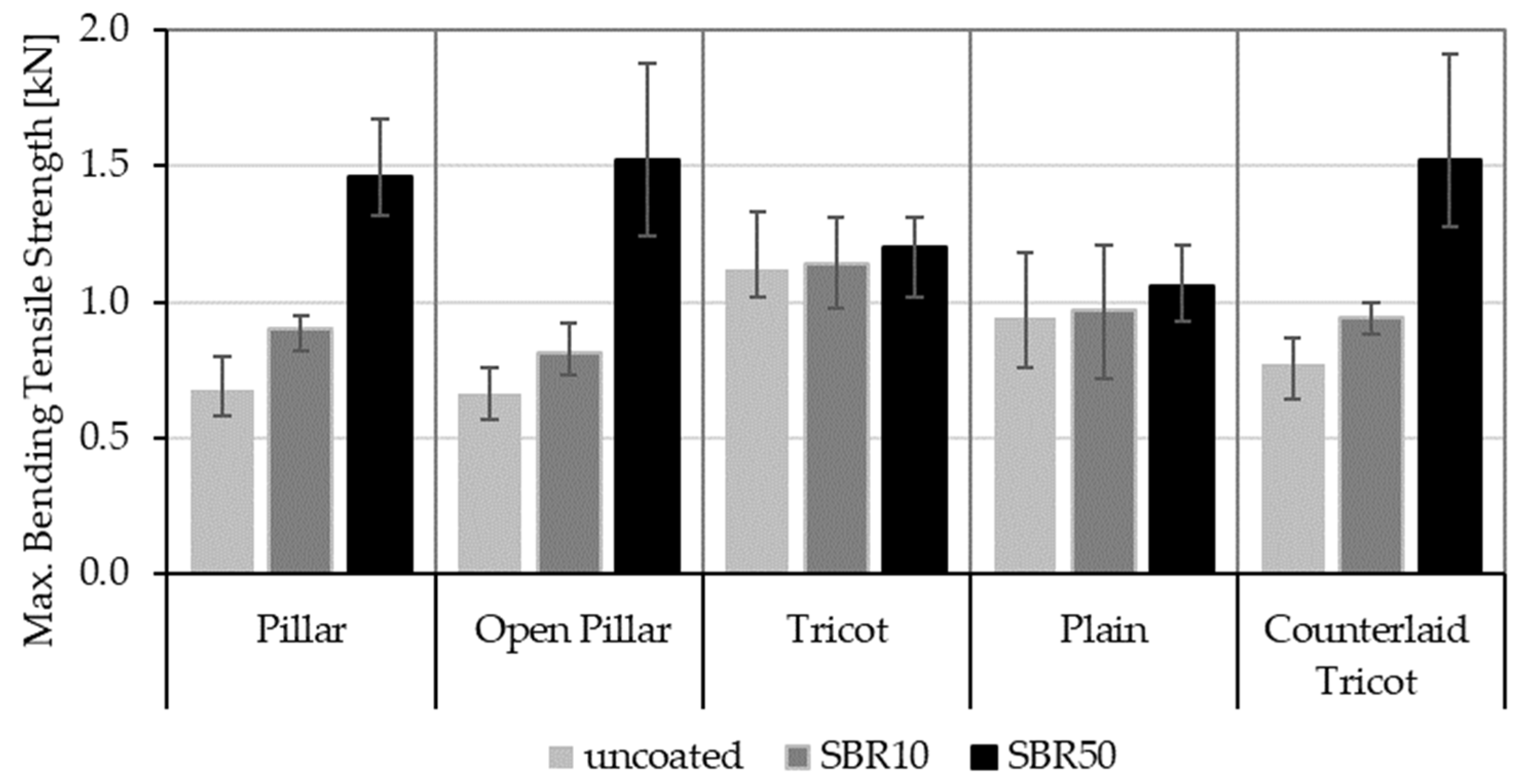
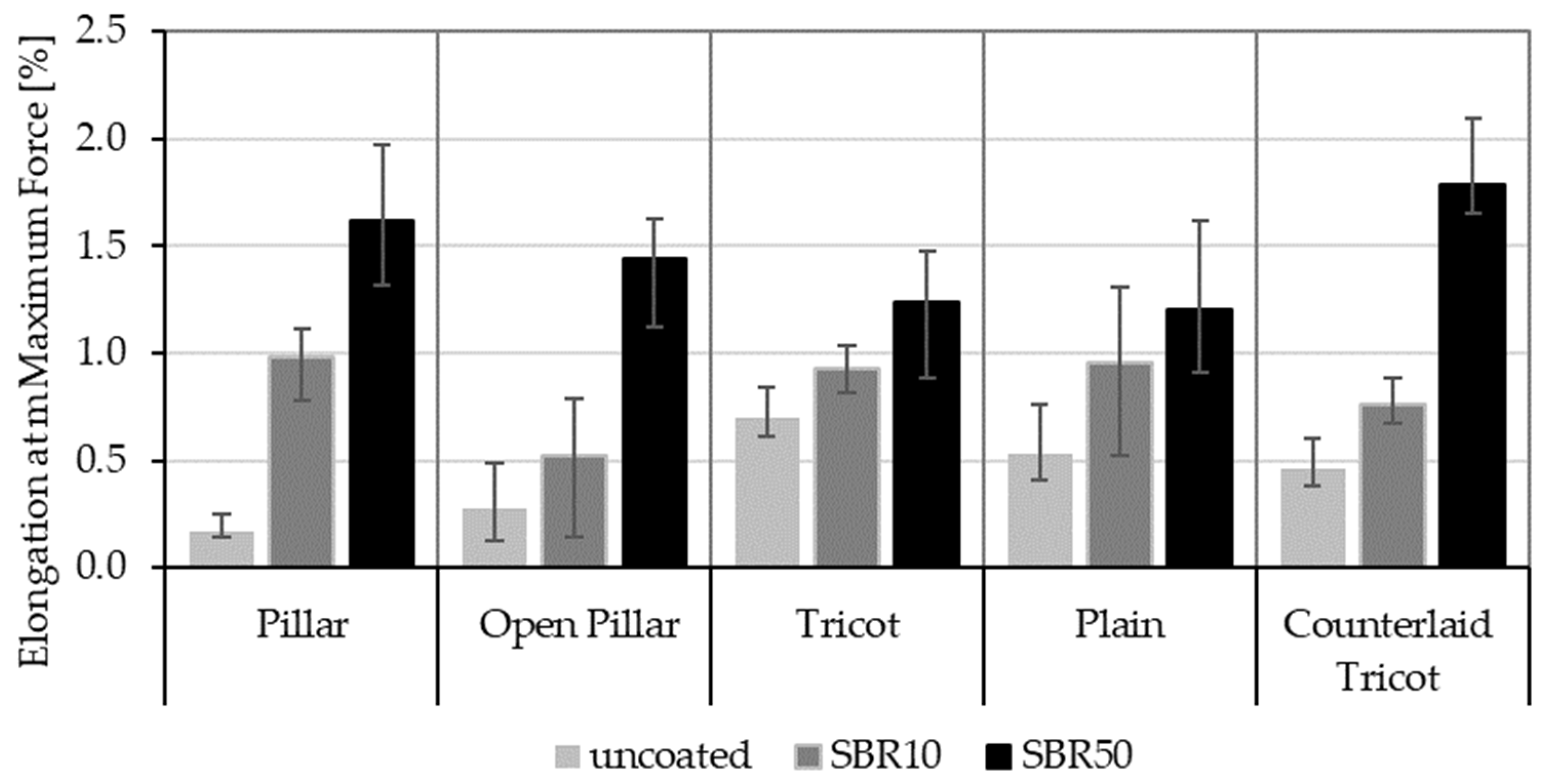

| Aim | Binding Type | Coating | Sample Configuration | Electrical Configuration | Insights/Observations | Ref. |
|---|---|---|---|---|---|---|
| Investigation of self-sensing potential under repeated (cyclic) loading | Pillar | uncoated | AR-glass/carbon-based TRC beam | Wheatstone bridge (DC) | Structure senses the mechanical load but loses linearity over time at the macroscopic level. | [26] |
| Investigation of self-sensing potential under monotonic loading | Pillar | uncoated | AR-glass/carbon-based TRC beam | Wheatstone bridge (DC) | Structure is able to sense the structural behavior at the macroscopic level. | [29] |
| Investigation of sensitivity of electrical resistance | Tricot Pillar | uncoated | Single C-roving, C-roving in concrete, and C-roving in polymer composite | DC Circuit | Resistance shows good correlation with strain. Binding type contributes to flexural behavior and electrical response. | [30] |
| Searching a correlation between electrical changes with micro- and macrostructural effects | Pillar | uncoated | AR-glass/carbon-based TRC beam | Wheatstone bridge (DC) | Changes in structural behavior under monotonic flexural loading process can be characterized over the loading range by the changes in the electrical reading of the carbon rovings. | [10] |
| Investigation of the relationship between the electrical response and the structural behavior to sense damage under cyclic mechanical load | Pillar | uncoated | AR-glass/carbon-based TRC beam | Wheatstone bridge (DC) | Sensory textile can differ between damage and internal microstructural effects. | [21] |
| Investigation of elasticity of carbon rovings embedded in concrete | Pillar | uncoated | Biaxial warp-knitted fabric with carbon and AR-glass | Wheatstone bridge (DC) | Change of resistance and elasticity is similar to metal. Tensions of C-rovings are measurable through elasticity, not following Hook’s law if higher than 0.2%. | [28] |
| Characterization of material properties of textile reinforcement equipped with carbon rovings | Tricot Plain Pillar | uncoated | Biaxial warp-knitted fabric with carbon and AR-glass | Wheatstone bridge (DC) | Binding types showed high tensile and shear forces. Four-point bending test demonstrate that k-factor aligns with yarn, plastic composite and concrete matrix. | [31] |
| Investigation of the effects of coating on the self-sensing capabilities under cyclic mechanical loading | Pillar | SBR15 | AR-glass/carbon-based TRC beam | Wheatstone bridge (DC) | Coating enhances mechanical performance but restricts the ability to sense the structural state and identify severity of the cracks. | [23] |
| Characterization of the electrical properties of carbon rovings due to mechanical strain and cracking at various structural states | Pillar | uncoated | AR-glass/carbon-based TRC beam | AC circuit | A carbon roving in a TRC beam is characterized by an RL electrical circuit, and the electrical properties (R and L) are affected by the geometrical properties of the roving and by the concrete matrix. | [32] |
| Properties | AR-Glass Rovings | Carbon Rovings |
| Manufacturer | Owens Corning | SGL Group |
| Number of filaments (k) | 3.2 | 24 |
| Filament diameter (µm) | 19 | 7 |
| Density (g/cm3) | 2.68 | 1.81 |
| Fineness (tex) | 2400 | 1600 |
| Tensile strength (GPa) | 1.7 | 5 |
| Young’s modulus (GPa) | 72 | 270 |
| Binding Type | Textile Structure | Knitting Sketch | Roving Shape |
| Pillar | 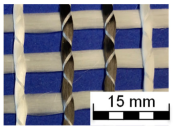 |  | Circular  |
| Open Pillar |  |  | Circular  |
| Tricot |  | 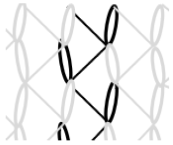 | Flat  |
| Plain |  |  | Flat  |
| Counterlaid Tricot |  | 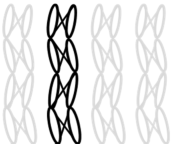 | Elliptical  |
| Coating Type | Textile Coating Percentages by Weight (wt%) | ||||
|---|---|---|---|---|---|
| Pillar | Open Pillar | Tricot | Plain | Counterlaid Tricot | |
| SBR10 | 3.1 | 2.7 | 3.6 | 2.7 | 3.5 |
| SBR50 | 14.6 | 11.0 | 18.4 | 20.5 | 19.4 |
| Cement CEM I 42.5 R | Sand 0.2–0.6 | Water | Fly Ash | Silica Fume | Quartz Powder | Plasticizer | Total | |
|---|---|---|---|---|---|---|---|---|
| Quantity (kg/m3) | 490 | 713 | 280 | 175 | 35 | 500 | 7 | 2200 |
| Uncoated | SBR10 | SBR50 | |
|---|---|---|---|
| Pillar |  |  | 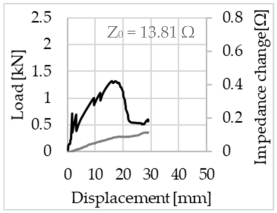 |
| Open Pillar | 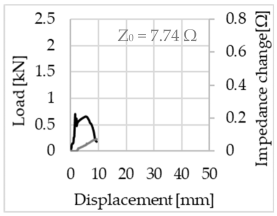 | 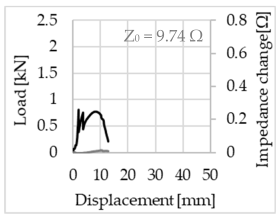 |  |
| Tricot |  |  |  |
| Plain | 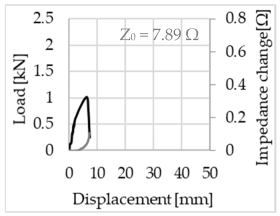 | 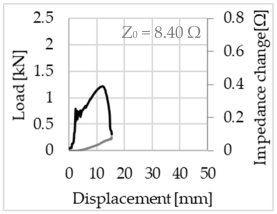 | 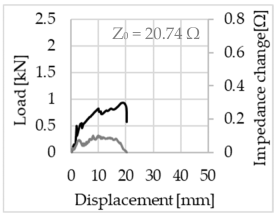 |
| Counterlaid Tricot | 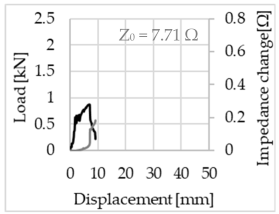 | 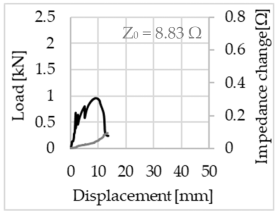 | 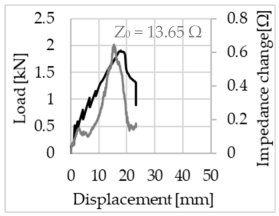 |
| Binding Type | Mean Value of Impedance Change ± Standard Deviation | ||
|---|---|---|---|
| Uncoated | SBR10 | SBR50 | |
| Pillar | (0.22 ± 0.14) Ω | (0.13 ± 0.08) Ω | (0.24 ± 0.35) Ω |
| Open Pillar | (0.11 ± 0.08) Ω | (0.09 ± 0.17) Ω | (0.50 ± 0.68) Ω |
| Tricot | (0.13 ± 0.04) Ω | (0.12 ± 0.06) Ω | (0.28 ± 0.24) Ω |
| Plain | (0.12 ± 0.03) Ω | (0.06 ± 0.02) Ω | (0.37 ± 0.37) Ω |
| Counterlaid Tricot | (0.22 ± 0.10) Ω | (0.08 ± 0.04) Ω | (0.56 ± 0.89) Ω |
| Binding Type | Total Crack Width (cm) | ||
|---|---|---|---|
| Uncoated | SBR10 | SBR50 | |
| Pillar | 0.108 | 0.162 | 0.285 |
| Open Pillar | 0.110 | 0.118 | 0.504 |
| Tricot | 0.052 | 0.092 | - |
| Plain | 0.037 | 0.192 | - |
| Counterlaid Tricot | 0.087 | 0.128 | 0.229 |
Disclaimer/Publisher’s Note: The statements, opinions and data contained in all publications are solely those of the individual author(s) and contributor(s) and not of MDPI and/or the editor(s). MDPI and/or the editor(s) disclaim responsibility for any injury to people or property resulting from any ideas, methods, instructions or products referred to in the content. |
© 2023 by the authors. Licensee MDPI, Basel, Switzerland. This article is an open access article distributed under the terms and conditions of the Creative Commons Attribution (CC BY) license (https://creativecommons.org/licenses/by/4.0/).
Share and Cite
Dittel, G.; Cicek, I.E.; Bredol, M.; Gries, T. Carbon Rovings as Strain Sensor in TRC Structures: Effect of Roving Cross-Sectional Shape and Coating Material on the Electrical Response under Bending Stress. Sensors 2023, 23, 4601. https://doi.org/10.3390/s23104601
Dittel G, Cicek IE, Bredol M, Gries T. Carbon Rovings as Strain Sensor in TRC Structures: Effect of Roving Cross-Sectional Shape and Coating Material on the Electrical Response under Bending Stress. Sensors. 2023; 23(10):4601. https://doi.org/10.3390/s23104601
Chicago/Turabian StyleDittel, Gözdem, Irem Ecem Cicek, Michael Bredol, and Thomas Gries. 2023. "Carbon Rovings as Strain Sensor in TRC Structures: Effect of Roving Cross-Sectional Shape and Coating Material on the Electrical Response under Bending Stress" Sensors 23, no. 10: 4601. https://doi.org/10.3390/s23104601
APA StyleDittel, G., Cicek, I. E., Bredol, M., & Gries, T. (2023). Carbon Rovings as Strain Sensor in TRC Structures: Effect of Roving Cross-Sectional Shape and Coating Material on the Electrical Response under Bending Stress. Sensors, 23(10), 4601. https://doi.org/10.3390/s23104601





